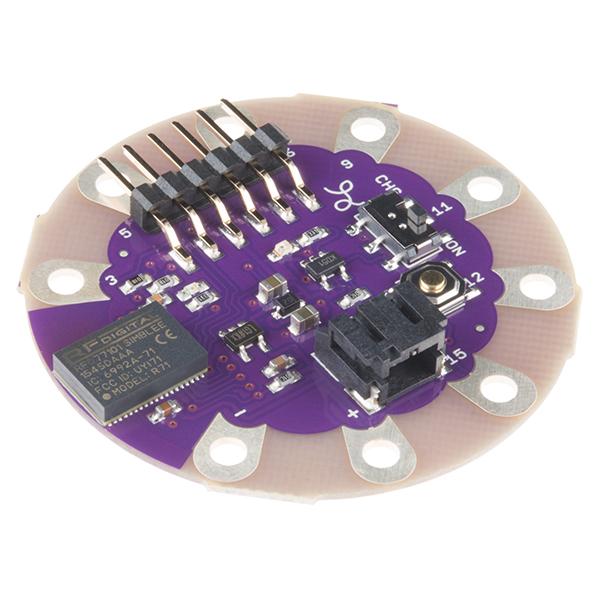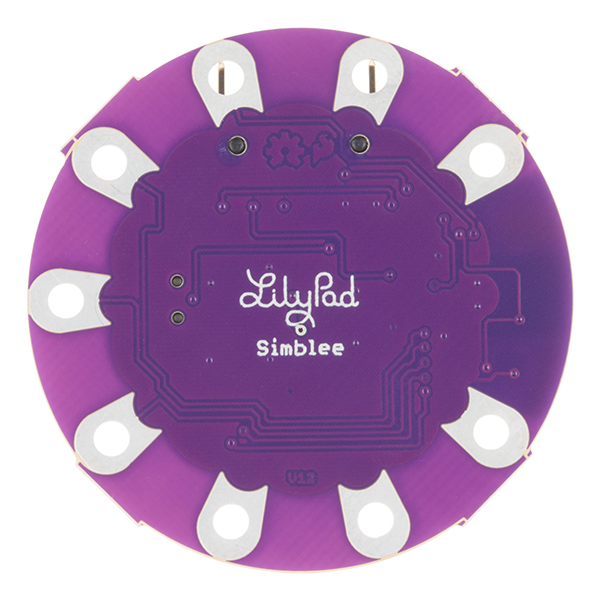LilyPad Simblee BLE Board - RFD77101
The LilyPad Simblee BLE Board is a wearable development board that allows you to add mobile application functionality via Bluetooth Low Energy (BLE, or Bluetooth 4.0) to your e-textile projects. Unlike other BLE solutions, the Simblee requires no specialized app development skills to realize the phone-side interface: all the necessary coding is done in the Arduino IDE and then uploaded to a browser app on the phone. With this board you will be able to create plenty of interesting wearable IoT projects!
The Simblee RFD77101 module, equipped to this board, is intended to make embedded devices using Bluetooth Low Energy connections easier for everyone: hardware hackers, app developers, students, makers, engineers, and anyone else who wants to leverage their smartphone via BLE. For more information on using the Simblee to create your own applications for embedded project, visit our Simblee Concepts tutorial found in the Documents section below.
This board also comes complete with a LiPo battery connector to roam wherever you need and a FTDI header to connect our LilyPad FTDI Basic or the 5V FTDI Basic programming boards. Each board has also been equipped with a Charge/Power switch to control power to the board. Our LilyPad line is designed for wearable electronics including pads big enough to sew into a project with conductive thread. If you prefer to solder to your boards, the LilyPad board does leave that option open as well.
Note: Please do not use the 3.3V FTDI Basic with this board, as it may not be able to source enough current from the 3.3V rail.
Note: A portion of this sale is given back to Dr. Leah Buechley for continued development and education of e-textiles.
- ARM Cortex M0 processor
- Bluetooth® Smart Stack built-in
- 128KB of Flash
- 24KB of RAM
- Integrated 16 MHz crystal and 32KHz precision crystal
- Integrated Antenna
- FTDI Programming Header
- Charge/Power Switch
LilyPad Simblee BLE Board - RFD77101 Product Help and Resources
Looking for the I2C pins on the LilyPad Simblee?
The I2C pins on the board are 5 (SCL) and 6 (SDA).
Core Skill: DIY
Whether it's for assembling a kit, hacking an enclosure, or creating your own parts; the DIY skill is all about knowing how to use tools and the techniques associated with them.
Skill Level: Noob - Basic assembly is required. You may need to provide your own basic tools like a screwdriver, hammer or scissors. Power tools or custom parts are not required. Instructions will be included and easy to follow. Sewing may be required, but only with included patterns.
See all skill levels
Core Skill: Programming
If a board needs code or communicates somehow, you're going to need to know how to program or interface with it. The programming skill is all about communication and code.
Skill Level: Competent - The toolchain for programming is a bit more complex and will examples may not be explicitly provided for you. You will be required to have a fundamental knowledge of programming and be required to provide your own code. You may need to modify existing libraries or code to work with your specific hardware. Sensor and hardware interfaces will be SPI or I2C.
See all skill levels
Core Skill: Electrical Prototyping
If it requires power, you need to know how much, what all the pins do, and how to hook it up. You may need to reference datasheets, schematics, and know the ins and outs of electronics.
Skill Level: Rookie - You may be required to know a bit more about the component, such as orientation, or how to hook it up, in addition to power requirements. You will need to understand polarized components.
See all skill levels
Comments
Looking for answers to technical questions?
We welcome your comments and suggestions below. However, if you are looking for solutions to technical questions please see our Technical Assistance page.
Customer Reviews
4.5 out of 5
Based on 2 ratings:
1 of 1 found this helpful:
Complete Simblee Implementation for Prototyping
At the time of writing this, there are a couple of Simblee variants out there: Lilypad, Breakout, and RFduino.
Only the Lilypad variant gives you a self contained board with Simblee, battery charger, and LiPo battery connector, and some basic pins for interfacing. This is the perfect package for prototyping portable BLE sensors, buttons, and other gadgets.
With an FTDI Basic, I was able to get going within a matter of minutes and build a BLE magnetic door sensor that I could deploy on the wall and forget!
I am not that interested in wearables, but time and time again, Lilypad has made the perfect miniaturized prototyping platform.
Bluetooth startup glitch
Needed to write terminal commands chmod +x /path before error 13 permission denied/ to get the bluetooth working. See thread https://digistump.com/board/index.php?topic=1813.0 similar problem but with digistump instead of Simblee.





Can you tell me how to run 8x NeoPixel Stick (https://www.sparkfun.com/products/12661 )with Lily Pad Simblee? I tried but no success.
I am using the Arduino IDE. After I uploaded the code the first time, I am not able to upload it the second consecutive time, without reset the board. 1. Is this the expected behavior? 2. Why does this happen? 3. Is there a fix?
This is not expected behavior at all. It sounds like there may be a bad solder joint or bad component on the board, breaking the connection between the FTDI board and the processor itself and disabling the auto reset circuitry. Check to make sure there aren't any missing components on the board, and contact tech support and see if they can help you out.
Can I connect this LilyPad Simblee BLE to an Arduino Nano board through I2C. Or do I need to put a converter (ex. CD4010BE ) between them?
Arduino Nano - Operating Voltage = 5V ( https://www.arduino.cc/en/Main/ArduinoBoardNano )
I am a total beginner, thanks for any advices.
Is it possible to interface SD card to Lilypad simblee?
Possible, but very difficult. You'd have to bit-bang the SPI interface, and that would use up four of the available pins AND probably make it impossible to use most of the existing libraries.
If SD is really important to you, I'd go with the standard Simblee Breakout. It would even be compatible with the RFDuino microSD shield that we sell.
Hi, I want to make sure that: I still can connect to my own android app. ui() and ui_event() are not necessary. Is it right?
I believe that is the case, but I don't know enough about Android app integration to be able to give you a 100% for certain answer.
Thanks for relying. I bought one and it can connect to my own android app.
What is the biggest LiPo battery this will charge? I put a 2000mAh battery on and it only worked an short time. Will this battery damage the board? I see the hook-up guide says it's set to 100mA charge rate, and good for 100mAh and higher LiPo's. Anyone using a big battery?
I happy with my new lilypad and does not have app for android :( It would be good to put it in the description, it only works with iphone for now
They've promised us an Android app soon; they originally said April, which is of course nearly over. I'll push them again and see if I can find anything out.
I will be pending
Simblee for Mobile app can now be downloaded from the app store on Android phones!
How many analog pins does this board have?
Pins 3, 5, and 6 can all be used as analog inputs. Reference them as analog 4, 6, and 7 respectively.